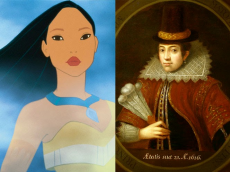
Most of us have seen the 1995 Disney film “Pocahontas”, telling the story of a Native American princess who brings peace between her tribe and the English settlers, whilst falling in love with the dashing John Smith along the way. I have always loved this film, and the music and animation is really rather stunning. It provoked my interest in Native American culture and it made me want to seek out the story of the real Pocahontas.
Sadly, it’s much less romantic than the film suggests. Pocahontas (real name, Matoaka – Pocahontas was just a nickname) was born in the last decade of the 16th century to Chief Powhatan and one of his wives. When the English settled in 1607 it is likely Pocahontas only would have been a child, not an adult as the film portrays her. John Smith was captured by her tribe but he did not meet Pocahontas until many months after this. There is evidence to suggest that Pocahontas was a friend to Smith and the Jamestown settler colony, as she played together with the children, and brought food when they were hungry.
One of the most famous scenes in the film is when Pocahontas throws herself over John Smith, in order to stop him from being killed by her father. Smith wrote a book, his “General History”, and he gives a personal account of what happened (from his viewpoint, obviously). Many historians have actually doubted whether it really happened or not, and some certainly believe that John Smith was exaggerating or telling a tall tale.
After his capture, John Smith returned to England for medical attention in 1609. This is the point at which the first film ends, but the film is too focused on John Smith as much more interesting things happened to Pocahontas after he left. She was captured by the English in 1613, and was held by them for a year. In this time, she was taught English and Christianity by a minister, and when she was allowed to talk to her father for the first time apparently she believed he did not value her and that she preferred to live with the English. She also met John Rolfe, who is depicted in the second Pocahontas film – but rather than being a dashing young gentleman, John Rolfe was an older tobacco plantation owner, a deeply religious man. Later they married but before this John Rolfe spent a lot of time wondering if it was even moral to marry a “heathen”. Their marriage was not really one for love, but a political one, to bring about an end to the war that was raging between Pocahontas’ tribe and the English settlers.
As in the second film, Pocahontas did come to England, but she was there as an example of how the Virginia Company had ‘tamed’ the natives. When she arrived, she learned that John Smith was alive, though the English had told them he was dead. She met with him in London, according to his History. But, when Pocahontas and Rolfe were leaving London to return to America, Pocahontas became sick, got off the boat at Gravesend (Kent) and died shortly afterwards. This is probably the most depressing reality – in the second film, she sails off into the sunset (literally!) with John Rolfe, but in reality she never made it back home.
The films are still important for inspiring young children to learn about Native American history, as it did with me, but like all things we must take it with a large pinch of salt. The music and animation, though, makes it one of the best films in the Disney series and Pocahontas is one of the only Disney “princesses” to be based on the life of a real woman.
Image from: http://aff95.teensdigest.com/articles/742?page=4

0 Comment:
Be the first one to comment on this article.